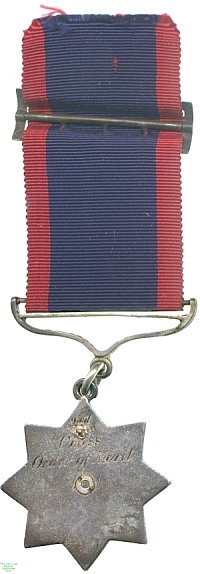
Obverse, a blue boss showing crossed swords in a circle with lettering around; a wreath around on an eight-pointed star

Reverse, an eight-pointed star plain save inscription

Obverse, a blue boss showing crossed swords in a circle with lettering around; a wreath around on an eight-pointed star |

Reverse, an eight-pointed star plain save inscription |
The Indian Order of Merit, instituted by the Honourable East India Company in 1837, is the oldest award for gallantry of the British Empire. The Order had three classes until 1912, for which medals were awarded in silver, silver and gold and gold respectively, and promotion from one class to a higher was achieved by further acts of bravery.
This medal was awarded to Subadar Jangbir Rana of the 8th Gurkha Rifles for his services on the Tibet campaign of 1903-1904. Tibet, on the frontier between the British possessions in India and the sphere of interest of expanding Russia, evoked the same kind of international political paranoia among British strategists as did the Indian North-West Frontier, and after a trade mission in 1903 had met with a hostile reception there a British expedition was sent that forced its way through to Lhasa, where new and more favourable trading arrangements were decided on in collaboration with the Chinese. Although the Dalai Lama of the time had fled to Mongolia at the British approach, the secular officials who agreed on the Treaty were able to confine the British to the city of Gyantse until 1944.
Some of the most vicious fighting on the British expedition was met with in and around Gyantse, and the Certificate for Subadar Rana's Order of Merit indicates that the award was made in respect of this, citing `his conspicuous gallantry during the assault on a village near Gyantse Jong on the 8th July 1904, when he climbed a wall ten feet high strongly held by the enemy. From this position he checked the fire of the enemy and killed several of them being himself wounded.'
This is one of four medals that were awarded to Subadar Rana that are now in the Watson Collection; the others follow. The medals are not attached to each other so although the Watson Collection catalogue considers them as Group 3 they have been treated separately here. Nonetheless, it was as a group that Lester Watson purchased them from the dealer Gifford, in 1928.